|

< Back to Career archive
1990-2001: The move to Audiovisual
A chance call to Murray Tregonning revealed that Intercity Hire was looking for a full-time hire coordinator. Intercity Hire was a national audiovisual company which had grown out of AAV’s Hire & Sales division, started at almost the birth of the serious AV industry in Australia. Television folk were apt to regard this part of the industry as rather “Mickey Mouse” and Hire & Sales were also known as “Toys & Boys”. However, I had done some audio work for them in the past and knew some of their staff. Managing the Melbourne office was Ron Cairns, ex HSV7 Technical Director and pioneer of video projection in Australia with the cumbersome (and by modern standards not very bright) GE Talaria. Ron and my paths had crossed while covering football back in the bad old days of black and white television. The upshot was that I got the job, albeit not at the money I would have wanted. The move to audiovisual was a great shock to my system and, at first, I saw it as a huge drop in status from television. This was the start of a very intense learning period for me with Ron Cairns very much my valued mentor.
It soon became apparent that, far from the closeted world of television full of specialists in their own departments, in audiovisual everyone was expected to be a “jack of all trades”. While everyone at Intercity turn their hands to almost everything, in a lot of cases the depth of knowledge was not very great, and I quickly learned that I would have something to offer in the field of audio. Unfortunately, my job limited me to the office most of the time, and this became an even more rigid confinement when I was promoted to Operations Manager. The only time I got out of the office was when satellite conferencing was required, where my audio knowledge came in very handy. The positive side of confinement to the office was that I was home most nights with my children, albeit tired and stressed from what was a very mentally demanding job. Phone calls could be expected twenty-four hours a day, from crew, freelancers, clients and venues. A carefully constructed crew schedule for the day could have turned to custard by early morning as clients demanded extra equipment, crew were sick or a van broke down. In addition, Intercity Hire was owned by “The Age”, which went into receivership shortly after I joined the Company. All salaries were frozen, new equipment was virtually unobtainable, and we were banished to a cheaper office and warehouse in East Brunswick far from the City which made operations even more difficult. I can remember making an emergency delivery to the Windsor one morning by dispatching a slide projector with the conductor on a tram!
Intercity computerised shortly after I arrived. Computers (286 processors with 2Mb ram) arrived on our desks one day, constituting the first-ever networked version of the DOS-based hire software “HirePoint”. We received little (read no) training and, one March morning, were told to start putting bookings into the computer. We tried to keep a paper-based system running in parallel for the whole morning and then gave it up as a bad joke. Either the computer system was going to work or it would not. In the long run, it was very successful and we all lost the pen calluses on our index fingers acquired through using carbon hire forms in triplicate. However, I kept the last of the blank paper-based hire forms in a frame above my desk marked “in case of emergency break glass”. I also discovered that PowerPoint could be used to make crude floor plans and, more importantly, schematics, so that the more complicated shows could not only be planned electronically but that records could be kept. Although I did not know it at the time, it was the start of my future career in production management.
However, there was to be a very enjoyable interlude before that career got underway. In early 1992 I was offered a job in the Historic Places Section of the then Department of Conservation & Environment. (I later discovered that the short pilot program in January 1990 had been a pre-job “test”). The job would run for a year, the money was better than that offered by Intercity, and the job was nominally nine to five which left me more time at home with my children. More importantly, I was being paid to practice my hobby and the huge stress of running the operations of Intercity would be lifted from my shoulders. I leapt at the opportunity. This was a hugely enjoyable period of my life, constantly challenged to learn new disciplines and surrounded by a stimulating crew of historians, planners, archaeologists and heritage architects. The job was to develop a methodology for the heritage assessment of sawmill and tramway sites as part of the Central Highlands Regional Forest Agreement process. In addition, the disturbance data generated by my study was fed into the Old Growth Study. I spent hours poring over old Lands and Forest records, months in the field tramping through the bush surveying sites, and many enjoyable hours interviewing those involved in the historic sawmilling industry. My study resulted in eighteen recommendations for addition to the Register of the National Estate and, by the time it was finished, I had gathered sufficient material for my first book.
When my year was up in July 1993 I was lucky enough to be able to walk straight back into a four-day per week job at Intercity as assistant to the National Operations Manager (much to the annoyance of the Intercity accountant who saw this as an unnecessary luxury). I also continued with freelance work in a resurgent television industry. The job at Intercity involved setting up some training programs and implementing standardisation as far as possible across the Intercity network. It also meant filling in as Melbourne Operations Manager whenever the person occupying the chair at the time could take the stress no more. A typical instance would see Intercity MD Peter Bramley come thundering over to my desk to exclaim that “Such-and-Such has stormed out in tears, you’ve got to go down there and sort it out”. Eventually, we went through sufficient operations managers that I was offered a decent salary to induce me to take the job on full-time.
As a sweetener, during this period “The Age” came out of receivership and Tim McMahon from AAV was appointed to transform the Company. It was re-named and re-badged as “Intercity Staging”, new equipment was purchased and the company began to expand again.
In early 1997, Intercity Staging was sold to the Gearhouse Group, an international AV company based in the UK. A very exciting period of expansion followed. Almost weekly a new container-load of equipment arrived, some clearly UK cast-offs, but most new and much coveted items. We also acquired some ex-Gearhouse UK employees who were to “teach us how to do AV” – however, with a few exceptions the reverse was actually the case. I managed to shrug off the job of Operations Manager, and joined Ron Cairns in “Special Projects”, working on the larger events. We acquired some of the very early ISDN teleconferencing equipment which quickly became known as “Ron and Pete’s toy television station” whilst, because of our ages, Ron and I were dubbed “Dad’s Army”. As junior partner, I bore this name with some pride.
In June 1997 I returned to the Historic Places Section to complete the historic sawmill and tramway studies for the North-East, Gippsland and West Regional Forest Agreements. A very interesting and productive two years followed which saw another forty-two sites added to the Register of the National Estate. In March 1999 with my part of the RFA process complete, I walked straight out of the Historic Places Section and back to Intercity Gearhouse (now called just Gearhouse) in new and enlarged premises in Port Melbourne under the management of Rhona Walker. By this time the company occupied three large warehouses dedicated to AV, Theming and Lighting. After a short period as a Project Manager, I joined Martin Featherston’s “Show Techniques” division and began the long collaboration with Peter Jones Special Events which continues to this day.

The Baptist Wold Conference in 2000 required an auditorium to hold 9,000
Probably my most memorable event at Gearhouse was the Baptist World Conference held at Jeff’s Shed in January 2000. Initially I was only to design and install the audio for this event of 9,000 pax but, at the last minute, I was thrown into the position of production manager for all the technical facilities. The set-up was quite complex, with a plenary auditorium for 9,000 and then forty breakout rooms distributed throughout the MECC complex. The climax of each day was evening worship and entertainment each night in the plenary auditorium we had constructed. This was covered with three cameras and shown on four large screens. The audio was probably the most complex part. The entertainment was different each night, with up to 300 performers on a busy night. The day started at 6.00 a.m. each morning with a production meeting to sort out the priorities for the day, and then there was rehearsal in the auditorium and breakout sessions to manage. The day ended at midnight with struggle to get out of the car park at the MECC so, after a three-day install and four days of conference we were all quite exhausted. The last function of the event was a thank-you breakfast for the staff and crew. When the speeches started I dutifully took my place at the audio console to look after the lectern mics. It just shows that such discipline eventually pays off, as I was then excused from a finale of hand-holding and hymn singing!
The Baptists were very pleased with the result, and I received one of the few gifts I have ever received from a client. Unfortunately for this heathen, it was a Bible!
However, by this time, the writing was on the wall for the Gearhouse Group which, to put it simply, had got too big too fast. The Lighting Division was sold off to Bytecraft, but the financial position of the Group did not improve. Accounts went unpaid and it became apparent to most staff the finances were in a parlous state. I was working on an IBM conference in Bangkok in February 2001 when we learnt from some English crew working on the same event that the Gearhouse Group was in receivership. Everyone nervously checked their tickets to reassure themselves that they indeed had a return flight...

Perhaps the best final word on Gearhouse came from this cartoon which was published in “Connections”, the AV trade magazine
Rhona Walker attempted to buy the Melbourne division (which was running at a profit), but the Receivers would only sell the Group as a whole. On 26 April 2001 the Receiver marched in and told us we had half an hour to gather our personal belongings and leave the building. Before he had finished speaking I had made a phone call and secured a position with Murray Tregonning & Associates. Shortly after that, Peter Jones called to confirm that I could still production manage the Centenary of Federation Reception that was only a week or so away. After a short production meeting, and a hurried rebooking of equipment and crew, I found myself on a plane for Sydney and two years of adventures at Club Muzz.
Next page >
|
 |
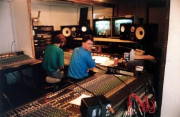
GTV colleagues Mike Smith (left) and Lindsay Wray (right) in “Carols by Candlelight” audio control – I worked on the audio production for this event until the late 1990s

The Intercity offices at 196 Normanby Road in South Melbourne
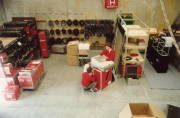
The Intercity warehouse at in South Melbourne, from where equipment was dispatched and received for shows all over Melbourne
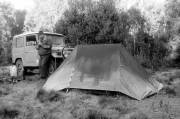
Camped at Yelland’s sawmill near Matlock in early winter 1992. Yes, that is ice on the tent. Combined with the frozen condensation on the inside of the tent, it stayed up even when all the pegs were withdrawn. I had to beat it flat with a stick and drag it into a patch of sun to thaw out...
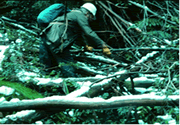
... and archaeology in the snow in the Upper Royston Valley. It could take several hours to progress one kilometre in such conditions
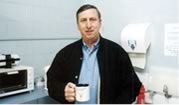
The senior partner of “Dad’s Army”, Ron Cairns
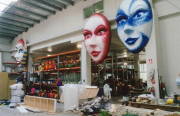
Part of the Gearhouse Themeing warehouse in Salmon Street, Port Melbourne
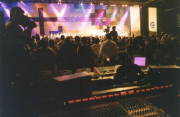
The control position for the Baptist World Conference – the PA for this event was massive and drew praise from those who attended, but there was still one African-American preacher who I could hear acoustically above the thundering PA!
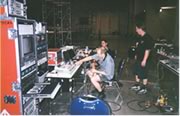
Control position in Bangkok – David Harrison at the console while Adam Pedretti stands behind him
|
